Women's foot size 41 which shoes to choose. Determination of leg fullness. Determination of shoe fullness, foot
Information on how to correctly determine your foot size and convert it to international will help you avoid accidental mistakes when buying shoes through an online store. Of course, such knowledge will not be useful when visiting a shoe boutique, because... The staff will help you choose the shoe size and the appropriate model.
This article will provide complete information about existing size tables, world scales and methods for independently determining shoes.
You can also ask your questions to the specialists of our portal.
In order to determine the size, you need to know that there are two measurement options:
- foot length (cm/mm);
- foot width (cm).
The concept of “size” has become a common mistake. When choosing shoes, it is necessary to take into account the length of the leg, the fullness of the foot, the height of the shin, as well as the country of the manufacturer.
Shoe manufacturers
In the Russian Federation, you can most often find manufacturers who provide a size range according to the European (EU) and Russian scale, which is expressed in millimeters.
On at the moment in the world there are four systems used in different countries Oh:
- CIS countries measure the foot exclusively in millimeters, regardless of the distance of the last, the possibility of putting on a warm sock, etc.
- Manufacturers from France (EUR) calculate the size of products based on the length of the inner insole and use a “bar” equal to 2/3 cm in the designation.
- English (UK) manufacturers use inches (2.54 cm) in measurements. A special feature of the size scale is the presence of size 0 (for newborns).
- American manufacturers use a similar sizing system to England (UK). The only difference is that the size range starts from size 1.
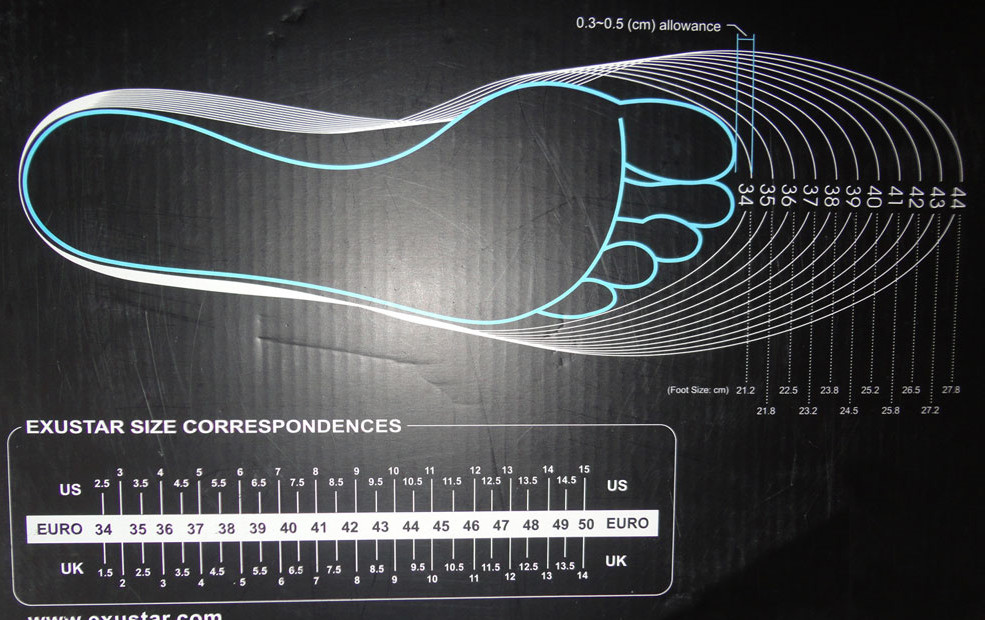
Attention!!! The Italian (EUR) manufacturer always indicates a size smaller than the Russian one. This is due to the fact that Italian brands, to please the client’s pride, deliberately underestimate the size range of both footwear and clothing. Otherwise, calculations are made according to the Euro grid (EUR), which allows you to choose the right product, taking into account the nuances.
In world fashion, the shoe manufacturing standard has long been adopted and used - ISO 3355-77, which implies that the foot is measured in millimeters. Subsequently, you can convert to centimeters, rounding to 0.5 cm. This standard does not take into account the shape and height of the last. Thanks to this factor, the system is understandable to the common man and allows you to choose the right products from different countries.
In order to avoid confusion in the designations, you can download the following document on our portal, which will help you choose the right shoes, regardless of the brand.
Determining the fullness of the leg
Knowing your foot width is just as important as the size itself, because it allows you to choose the right shoes. It is most important to know the required completeness, especially in cases where the material of the product has a rigid structure (skates, rollers, etc.).
More often, foot width (fullness) is divided into:
- narrow;
- average;
- wide.
Leg fullness is measured by the part of the foot that is widest. The term “fullness” is also called “block”.
According to GOST No. 3927-88 adopted in Russia, the fullness of shoes for men and women is indicated by numbers 1 to 12 with 4 mm intervals. Under the Soviet Union, products had different designations. IN present moment they are almost identical to the Euro-grid (EUR).
England (EUR) and America use in their systems letter designation shoe fullness: A, B, C, D, E and F with 5 mm intervals. Digital numbering is used only in Russia, France and the European (EU) system. It contains gradations 1-8 with 5 mm intervals.
On the portal you can download the correspondence table:
How to determine your shoe size?
Before ordering a product, no matter from a European (EU) manufacturer, Russian or Asian, our portal experts recommend using the tips below:
- Take all measurements better in the evenings, since at this time the greatest flow of blood flows to the legs, which leads to some enlargement of the foot.
- Be sure to measure all two feet. There are cases when the legs differ by several cm, then take the largest length option as a basis.
- Also measure the size while wearing socks, tights, etc., so as not to encounter the fact that the shoes turn out to be small when put on something.
Before using the correspondence table, you must determine the size according to the following scheme:
- stand on a piece of paper and trace the outline of your leg;
- measure the distance from heel to end thumb;
- For convenience, the result obtained can be rounded by 5 mm, no more is needed.
For further determination, there is a special table on our portal, which is located at the bottom of the section.

Fullness is measured in centimeters, focusing on the widest point of the leg. And it’s also difficult to determine this by eye, so there is a formula for calculation that is suitable for both male and female feet:
W = 0.25B – 0.15C – A, in which:
W, this is the resulting completeness;
B, this is the circumference of the measured foot (mm);
C, is the foot length (mm);
A, this is an unchangeable coefficient, for men - 17, for women - 16.
Having this formula at hand, making calculations does not seem difficult, so you can determine the fullness of your feet in relation to the necessary shoes yourself. And after measuring the fullness of the foot, it will be easier for you to select the necessary product using a converter.
In addition to tables, on manufacturers’ websites you can find converters that will help in converting Russian sizes to foreign ones.
You can download the following document for free to help you choose the right shoes:
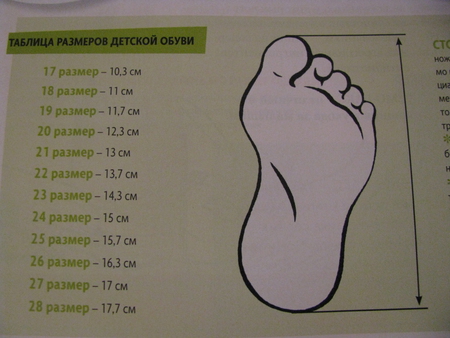
When ordering footwear from different manufacturing countries in an online store, be it England (UK), Italy or Europe (EU), a significant drawback is the lack of fitting options. But despite this, the trend for shopping through online services remains popular. This is due to the fact that almost all manufacturers provide full information about the product and there is a return option.
Make sure that the quality of the product matches its price. If these are not domestically produced shoes, then previously for a few euros (EUR), you could buy passable shoes. And now the price has risen and varies by several hundred euros (EUR). In Russia, they ask for several thousand rubles for a good product. Due to the fact that exchange rates and the euro (EUR) in particular have risen, the demand for international manufacturers' stores is decreasing. Be careful when ordering on foreign websites and pay attention to fixed prices at the time of ordering.
All shoes, no matter whether they are for sports or for everyday walking, when selected, should be based on the proposed size and the correspondence of this size to the parameters of the length and width of the foot. As mentioned above, specialized tables will help you sort out the size ratio.
Additional tips:
- purchasing small shoes will result in discomfort and pain in your feet;
- shoes large size leads to the appearance of calluses, blisters, etc.;
- It is recommended to take measurements at least once a year, because the foot can change due to various factors;
- take measurements in centimeters;
- If you have difficulty working with tables, use a converter.
People visit every season shoe stores. And many are familiar with the situation when there are no suitable shoes. Looks like I really liked the pair of shoes. You tried it on, but it turned out to be big, or maybe, on the contrary, small, but there is no smaller or larger size. And sometimes everything happens exactly and vice versa: there is right size, but, unfortunately, the shoes are not attractive in any way.
Each shoe size corresponds to specific measurements. Namely: the length and fullness of the feet. The second is measured at a place with a larger width, in the forefoot. People don’t always manage to find suitable shoes precisely because individual characteristics this part of the leg.
Many people advise purchasing models made from genuine leather. Such shoes can easily “adapt” to any foot shape. Of course, shoes, shoes or boots made of genuine leather are quite expensive. But the price is worth it. Very often leather shoes It also has heels that calculate the load on the spine and soften it.
The right shoes
To choose shoes that will not cause any harm to the health of your feet and will be pleasing to the eye, you need to take into account the individual characteristics of your foot structure.
If you decide to order shoes from a manufacturer, then visit the store and try on several models. This is the only way you can choose the right size. If you didn’t find anything suitable, and you will be buying from a German manufacturer, then you can try on any shoes made in Germany. The fact is that in this country there are no differences in size.
If you decide to order, but cannot find shoes from the right manufacturer in stores, you will first have to figure out the size. How to do this? First of all, you should decide on the volume of your foot. The shoe width measurements and table will help with this.
To determine your shoe size you need:
1. All measurements should be made in the evening. At this time, the leg always becomes larger than in the morning or afternoon.
2. Take a piece of paper and place your foot on it, then trace the line of your foot. If you will be wearing socks with your shoes, you should outline the outline of your feet while wearing them.
3. Use measuring instruments to determine the length and fullness of the foot. The length is easy to measure. Fullness is determined by the widest area in the toe.
4. Compare the data obtained with the tabular ones and find the appropriate size. This is why you need a shoe fullness table.
European sizes
Each country has its own shoe size tables. In the case of clothing, the situation is the same. American and european sizes may differ slightly from Russians, so you need to rely on measurements related to sizes, and not on the relationship between different sizes.
Shoes, as you know, are divided into men's and women's. The sizes of both shoes are different. When determining the size and table, you must use the appropriate one.
Women's shoe size chart
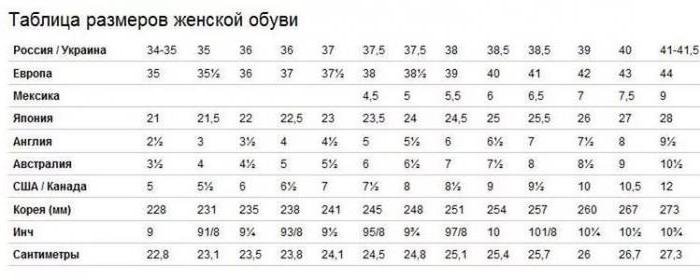
Shoes for women are smaller in size than men's. Therefore, there is a separate size table for it. It helps a lot in such cases when you need to place an order on the Internet, or rather in an online shoe store!
Men's shoe size chart
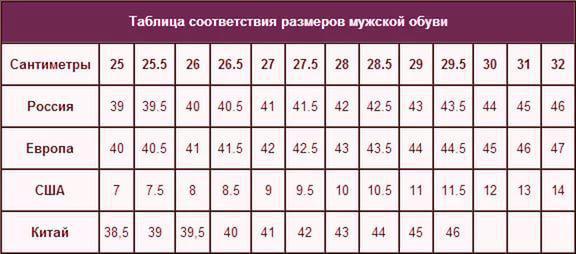
As already mentioned, men's shoes are different from women's. A separate size table was created for it. She is also an excellent assistant when choosing boots and sneakers on the Internet.
Fullness of shoes
When choosing shoes, you need to take into account its size and suitability (fullness). You need to use the completeness table. Since women's and men's shoes are different, the shoe completeness tables will be different.
Women can easily order shoes from online stores. A table of the fullness of women's shoes will help them with this. To use it, you just need to measure the widest part of the foot and compare the indicator with the measurements in the table.
As you can see from the table, this is quite simple to do.

To select shoes for the stronger sex, there is a table of completeness men's shoes. The principle of operation of the table is no different from that described above. First, measure the fullness of your own foot, and then compare the data obtained with the measurements indicated in the corresponding column. The shoe fullness chart is a great help. Especially when suitable model not available in stores located nearby.

Shoes for children should also be selected according to these two important parameters. To choose the right boots, be sure to take into account the appropriate pattern. When ordering online, don’t make a mistake; the shoe fullness table will always help you with this.
Conclusion
Fullness, in fact, is a distinctive parameter of shoe sizes from manufacturers in different countries. Don't be afraid to buy shoes on the Internet. The shoe size chart will always help you choose the right size! Making an order online is not at all difficult if you use the information presented in this article.
Everyone's feet are very different. Shoe manufacturers have different lasts. If you know the ideal block (manufacturer) for you, that’s good for you. On the other hand, good leather is the material that can adapt to your foot. When buying shoes from catalogs, you can be sure that they comply with all the technologies that are stated there. Genuine Leather, special systems heels designed to relieve stress on the spine, breathable membranes and much more.
Advice!The best way to determine your size to order from catalogs is to try on shoes from the manufacturer you want to order in a store. If you can’t find this particular manufacturer, then try on any pair of German shoes.
If you are not sure about your shoe size or think that you have wider feet, then we have tried to find some recommendations for you. The size tables are taken from the gerbruder gots catalogue, the size recommendations table is based on materials on the Internet.
Conversion table between German and English shoe sizes. Women's and men's shoes.
|
Sizes for children's shoes.
|
Fullness of shoes.
 |
The fullness of the shoe is measured at the widest points of the toe box using a centimeter, as in the figure.
|
||||||||||||||||||||||||||||||||||||||||||||

Table of fullness (rise) in cm for each size.
| Size | Fullness (rise) in cm | ||||||||
| 2 | 3 | 4 | 5 | 6 (F) | 7 (G) | 8 (H) | 9 (J) | 10 (K) | |
| 35 | 19,7 | 20,2 | 20,7 | 21,2 | 21,7 | 22,2 | 22,7 | 23,2 | 23,7 |
| 36 | 20,1 | 20,6 | 21,1 | 21,6 | 22,1 | 22,6 | 23,1 | 23,6 | 24,1 |
| 37 | 20,5 | 21,0 | 21,5 | 22,0 | 22,5 | 23.0 | 23,5 | 24,0 | 24,5 |
| 38 | 20,9 | 21,4 | 21,9 | 22,4 | 22,9 | 23,4 | 23,9 | 24,4 | 24,9 |
| 39 | 21,3 | 21,8 | 22,3 | 22,8 | 23,3 | 23,8 | 24,3 | 24,8 | 25,3 |
| 40 | 21,7 | 22,2 | 22,7 | 23,2 | 23,7 | 24,2 | 24,7 | 25,2 | 25,7 |
| 41 | 22,1 | 22,6 | 23,1 | 23,6 | 24,1 | 24,6 | 25,1 | 25,6 | 26,1 |
| 42 | 22,5 | 23,0 | 23,5 | 24,0 | 24,5 | 25,0 | 25,5 | 26,0 | 26,5 |
| 43 | 22,9 | 23,4 | 23,9 | 24,4 | 24,9 | 25,4 | 25,9 | 26,4 | 26,9 |
| 44 | 23,3 | 23,8 | 24,3 | 24,8 | 25,3 | 25,8 | 26,3 | 26,8 | 27,3 |
| 45 | 23,7 | 24,2 | 24,7 | 25,2 | 25,7 | 26,2 | 26,7 | 27,2 | 27,7 |
| 46 | 24,1 | 24,6 | 25,1 | 25,6 | 26,1 | 26,6 | 27,1 | 27,6 | 28,1 |
| 47 | 24,5 | 25,0 | 25,5 | 26,0 | 26,5 | 27,0 | 27,5 | 28,0 | 28,5 |
| 48 | 24,9 | 25,4 | 25,9 | 26,4 | 26,9 | 27,4 | 27,9 | 28,4 | 28,9 |
What to look for when buying shoes
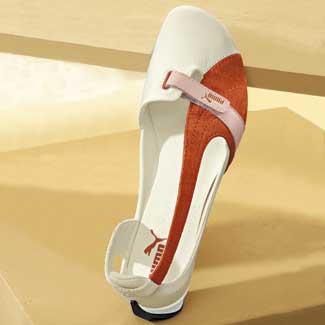
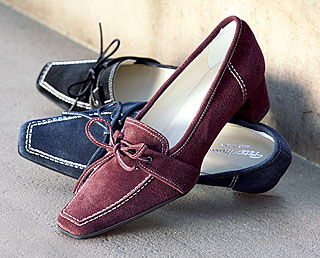
When buying shoes from catalogs, you can be absolutely sure of the material from which the shoes are made - fakes are excluded here.
- Each manufacturer has its own block. Each foot has its own characteristics, and it is impossible to create the optimal shoe for everyone. It's best when you know which brand's shoes suit you.
- Wide and narrow feet, as well as wide and narrow ankles sometimes cause a lot of problems. The best option in in this case- shoes with laces, which allow you to vary the shaft according to at will. Stocking boots perform the same function. Nowadays, shoe manufacturers use various tricks so that you can choose the width of the shoes and the shaft to suit you.
- Buy your shoe size. Shoes must fit. Not cramped, not big.
- You should not buy shoes for children to grow into. This can lead to flat feet.
- And vice versa. Avoid tight shoes. Some girls wear shoes one size smaller to visually make their large feet appear smaller. Some people think that this way you can stop the growth of your leg. Our advice is to buy shoes in your size, otherwise you cannot avoid problems that worsen over the years: pain, swelling, salt build-up, deformation.
- The best option is leather shoes. Buy shoes made from natural materials. Shoes made of genuine leather are easy to wear and take the shape of the foot.
- Tough and durable is better for winter cowhide(from cattle hides).
- Pigskin It is not inferior to it in quality, but it looks worse.
- The most expensive, practical and beautiful material - kid(goatskin leather). High price in this case it is completely justified.
- A little cheaper opoek(leather from the skins of dairy calfs). It is ideal for summer shoes: it is thin, breathable, but not the most durable leather.
- Suede quite expensive, it is made from the skin of the high quality. Nubuck much cheaper (leather with raw material defects that will disappear after sanding is also suitable for it), but at the same time it has good hygienic characteristics. Shoes made of suede and nubuck require special care, without which they quickly lose their appearance. In rain and slush, it is better to leave boots or shoes at home; moisture is destructive for suede and nubuck. It is better to wear such shoes in the summer, but in dusty weather you should take a special brush with you, otherwise by the evening you will not recognize your smart shoes.
- Moisture and salt are perfectly tolerated by natural patent leather shoes, in which it is quite comfortable even at a temperature of 12-15 below zero.
- Leatherette shoes it is short-lived, has temperature restrictions and does not allow air to pass through, which can result in an unpleasant odor. True, products made from high-quality leatherette have one advantage: they do not get wet. Therefore, having a pair of faux leather boots for very wet, rainy weather makes perfect sense.
- Synthetic shoes are not always cheaper. Especially if they try to pass it off as leather. Today, the choice of shoes is quite large, and it is quite difficult to distinguish genuine leather from fake leather. Modern fake leather has become so good that sometimes only a specialist can distinguish natural material from artificial one. It is useless to drag a lighter over the leather - high-quality leatherette can withstand this test. The characteristic smell is not an indicator either, since counterfeit manufacturers have long learned to scent their products. The easiest way is to look at the skin from the inside out. If the material splits into small hairs when cut, most likely it is genuine leather; if it splits into strings, then it is artificial. True, this method is not a panacea. Often the manufacturer hides all the cuts, or glues the substitute with the wrong side of natural leather. In products made from genuine leather, the seams are rarely hidden inside; more often they are external, so the cut is clearly visible to the buyer.
- Avoid closed shoes in summer so that your feet can breathe. This is especially true for men. Wear sandals and sandals. In hot weather, the foot feels great in canvas shoes or leather shoes with fabric inserts. Unfortunately, the fabric is impractical, and such shoes quickly lose their appearance.

Walking in high heels is an art. If you haven’t worn high heels for a long time, for example, in winter, and suddenly decide to show off nine-centimeter stilettos, by the evening you will fall from fatigue. But if you are firmly convinced that beauty requires sacrifice, give your feet a chance to get used to stilettos. First, wear shoes with five-centimeter heels. This particular heel is considered harmless to health. Having mastered this height, try the next pair, with a heel of seven centimeters. As for the nine-centimeter stiletto, this height is almost extreme. Orthopedists do not advise constantly wearing such shoes, especially for young girls with weak ankle joints.
![]()

For example, shoes with the ANTISHOKK system in the heel, which reduces stress on the spine and protects the spine, intervertebral cartilage and joints from deformation, eliminates discomfort and creates good health. You can purchase such shoes from manufacturers such as Tamaris, Jenny, Sally O'Hara.
Insoles and soles are made in such a way that they provide a microclimate in the shoes: optimal temperature and humidity, and air circulation are maintained. Various membranes with micropores that are smaller than a drop of water, but larger than a molecule of water vapor, which allows even rubber soles to “breathe”, releasing sweat and preventing moisture from entering the shoes.
- How high should the heel be? so that the gait remains correct and beautiful? For women, heels up to five centimeters are considered safe. And for men, the recommended heel height is one and a half centimeters.
- Technologies do not stand still. This also applies to shoes. Now manufacturers are offering new developments that make shoes more comfortable.
To To choose the optimal shoe model, you need to know two main parameters: foot length and fullness.
The difference between sizes is 5 mm. 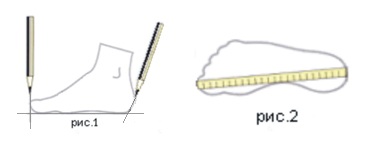
*When measuring your feet, outline your feet like an insole, that is, start outlining your feet from the bottom of the heel and lead the pencil to the big toe. There should be an insole on which you take measurements. Do not outline the protruding part of the heel, but hold the pencil at an angle to outline only the heel insole
Before you start directly measuring, here are some useful tips.
1. Measurements are best taken at the end of the day when the size of the leg increases due to blood flow.
2. Put on socks – you won’t be wearing shoes on your bare feet.
However, be careful - a sock that is too thick, for example, grandma's self-knitting, can seriously affect the accuracy of sizing.
Foot Length: 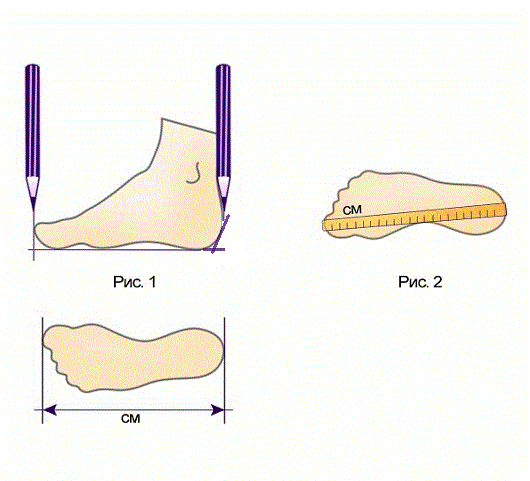
Place both feet (in socks) on a piece of paper and trace with a pencil. Measure the distance from your heel to your big toe. If the lengths for the right and left legs are different, choose the longest one. We recommend measuring both legs and taking the largest result as a basis. Outline the foot with a pencil. The pencil should be in a strictly vertical state, without losing contact with the foot. Measure the distance between the outermost points of the drawing. (Fig. 2)
Round the resulting value up. This will be your foot length. Measure the distance between the most distant points along the length of your foot with a centimeter. Round the resulting date to millimeters and determine your size using the table (see below).
Find in the table below what size your foot length corresponds to. Foot length for example:270, which corresponds to size 41.
That's what we got Russian size shoes The domestic sizing system has a number of advantages. Firstly, it is metric and complies with the international standard ISO 3355-77. Secondly, the measurement technique is such that you can easily determine the size of the shoe without making adjustments to the shape of the lasts.
How to determine the fullness of your legs.

A very important size parameter is fullness.. Which, basically, determines the comfort of the shoe, as shoemakers say, its “fitness.” According to GOST 3927-88 male and women's shoes should be produced in 14 completenesses, about 17 completenesses are known. The gap between the fullnesses is 5 mm. Shoe factories in many countries, for market reasons, specialize in producing shoes of only certain widths - narrow, medium or wide. We can produce any width.
Example No. 1
Measure the circumference of your foot at the widest part,
(I.e., measured at the widest points of the toe part using a centimeter). Then simple calculations are carried out.
Example 2) Table No. 1
- for summer shoes,
foot circumference 245, and foot length 270, which means your size is 41, fullness is 8.

|
Size. Length of trace in mm. |
completeness 7 mm. |
completeness 8 mm. |
completeness 9 mm. |
completeness 10 mm. |
completeness 11 mm. |
completeness 12 mm. |
|
280
|
Table No. 2
, for autumn-winter shoes,
foot circumference 250, and foot length 270, which means your size is 41, fullness is 8.
|
Size. Length of trace in mm. | ||||||||||
To designate shoe sizes, several numbering systems are used, which got their name depending on the original unit of measurement for the length of the last (foot) footprint: inch (1 inch is equal to 2.54 cm), centimeter, millimeter, pin (6.67 mm.).
In Belarus, as in the CIS countries in general, when determining the size, the length of the foot is taken into account, without allowances for decorative elements of lasts, warm socks, etc. That is, regardless of whether the shoes have a round or narrow toe, the size indicates what length of foot they are intended for. Of course, how a shoe fits on your foot depends on the model and the characteristics of the foot, but in general this system remains the most accurate and easiest to determine. Below are foot measurement guidelines and a sizing chart.
To determine your shoe size, you need to measure your foot. It is recommended to do this at the end of the day, because... the legs trample and become larger. Stand on a piece of paper and trace your leg with a pencil. To determine your foot length, measure the distance between the most convex points (A and B), as shown in the figure. You need to measure both legs and choose the longer length. Round the result to 5 mm and find your size in the table.
Table for determining the sizes of women's and men's shoes
| Women's | |||||||||||||
| Non-mass system | 34 | 35 | 36 | 37 | 37,5 | 38 | 38,5 | 39 | 40 | 41 | 41,5 | 42 | 42,5 |
| Metric system (see) | 22,5 | 23 | 23,5 | 24 | 24,5 | 25 | 25,5 | 26 | 26,5 | 27 | 27,5 | 28 | 28,5 |
| Men's | |||||||||||||
| Non-mass system | 38,5 | 39 | 40 | 41 | 41,5 | 42 | 42,5 | 43 | 44 | 45 | 46 | 47 | 47,5 |
| Metric system (see) | 25,5 | 26 | 26,5 | 27 | 27,5 | 28 | 28,5 | 29 | 29,5 | 30 | 30,5 | 31 | 31,5 |
To determine your child's shoe size, you need to measure your foot. It is recommended to do this at the end of the day, because... by evening the legs trample and become larger. Put on the socks with which he will wear shoes and measure the feet together with them. This is especially important if you are going to buy winter shoes, as there is a greater chance that the child will not outgrow the boots before the end of the season. Place your child on a piece of paper and trace both feet with a pencil. In the resulting drawing, measure the distance between the most distant points. If the lengths for the right and left legs are different, select the largest result. Find the required size in the table, taking into account that shoes are selected with a margin of 0.5 - 1 cm.
The “Metric system” column indicates the length of the foot in centimeters for which the size is designed.
In the column “Insole length” the actual length of the insole is indicated, i.e. the insole is always 0.5 cm larger.
Orthopedists do not recommend leaving a margin greater than 1 cm (1.5 cm free is allowed for winter shoes).
For example, shoes of size 20 will fit a foot of 12 - 12.5 cm (half a centimeter of free space must be required).
Remember that you need to measure your feet standing child, since under the weight of the body its length becomes greater than when weighed.
Table for determining the sizes of children's and teenage shoes
| Children's shoes | ||||||||||||||
| Non-mass system | 17 | 18 | 19 | 20 | 21 | 22 | 23 | 24 | 25 | 26 | 27 | 28 | ||
| Metric system (see) | 10,5 | 11 | 11,5 | 12,5 | 13 | 13,5 | 14,5 | 15 | 15,5 | 16,5 | 17 | 17,5 | ||
| Insole length(cm) | 11 | 11,5 | 12,5 | 13 | 13,5 | 14,5 | 15 | 15,5 | 16,5 | 17 | 17,5 | 18 | ||
| Children's and teenage shoes | ||||||||||||||
| Non-mass system | 29 | 30 | 31 | 32 | 33 | 34 | 35 | 36 | 37 | 38 | 39 | 40 | ||
| Metric system (see) | 18,5 | 19 | 19,5 | 20,5 | 21 | 21,5 | 22,5 | 23 | 23,5 | 24,5 | 25 | 25,5 | ||
| Insole length (cm.) | 19 | 19,5 | 20,5 | 21 | 21,5 | 22,5 | 23 | 23,5 | 24,5 | 25 | 25,5 | 26 | ||
The fullness of shoes and how to determine it
An important parameter is completeness, which mainly determines the comfort of the shoe, as shoemakers say, its “fitness.”
Feet with the same length have different fullness, i.e. circumference of the metatarsal heads. The interval between adjacent fullnesses in the metric system is:
- 8 mm – for casual shoes;
- 5-6 mm – for dress shoes.
According to GOST 3927-88, men's and women's shoes must be produced in 12 thicknesses and are designated by Arabic numerals from 1 to 12.  About 17 completenesses are known abroad. According to the English system, the gap between fullnesses is 5 mm, the fullnesses are designated by letters (A, B, C, D, E and F). According to this system, there are five more fullnesses in the direction of decreasing girth (2A, 3A, 4A, 5A and 6A) and five increased fullnesses (2F, 3F, 4F, 5F, 6F). There are completenesses E2, E3, E4. There are other complete numberings: alphabetic - WWW, WW, W, M, S, SS, SSS. Shoe factories in many countries, for market reasons, specialize in producing shoes only in certain thicknesses - narrow, medium or wide.
About 17 completenesses are known abroad. According to the English system, the gap between fullnesses is 5 mm, the fullnesses are designated by letters (A, B, C, D, E and F). According to this system, there are five more fullnesses in the direction of decreasing girth (2A, 3A, 4A, 5A and 6A) and five increased fullnesses (2F, 3F, 4F, 5F, 6F). There are completenesses E2, E3, E4. There are other complete numberings: alphabetic - WWW, WW, W, M, S, SS, SSS. Shoe factories in many countries, for market reasons, specialize in producing shoes only in certain thicknesses - narrow, medium or wide.
The fullness of the shoe is measured by girth at the widest points of the toe box using a centimeter, as in the figure.
Completeness correspondence table for the main marking systems
| French | 1 | 2 | 3 | 4 | 5 | 6 | 7 | 8 | 9 | 10 |
| English | A | B | C | D | E | F | G | H | J | K |
| American | AAAA | AAA | A.A. | A | B | C | D | E | E.E. | |
Fullness of shoes according to the English marking system:
- type "F" - for normal legs;
- type "G" - for stronger ("massive") legs;
- type "H" - for full legs (wide feet with wide bones);
- type "H 1/2" - for very full legs (very wide feet with wide bones);
- If the fullness is not indicated, then the shoes are of normal fullness.







